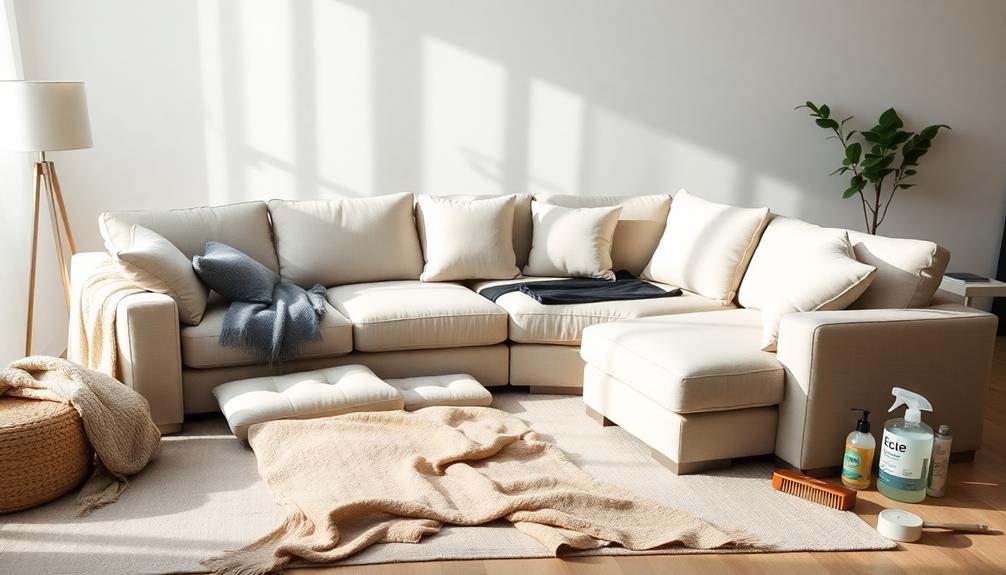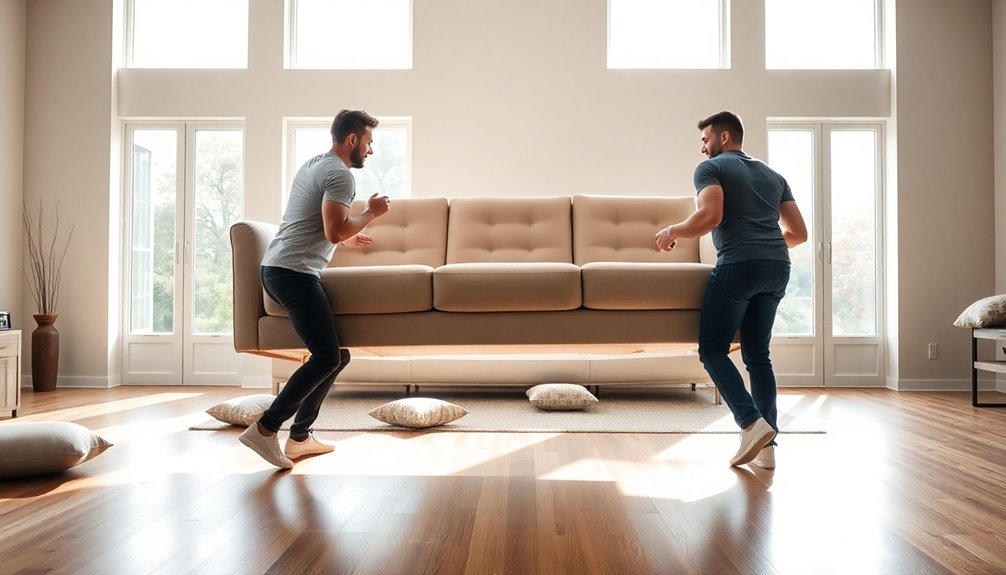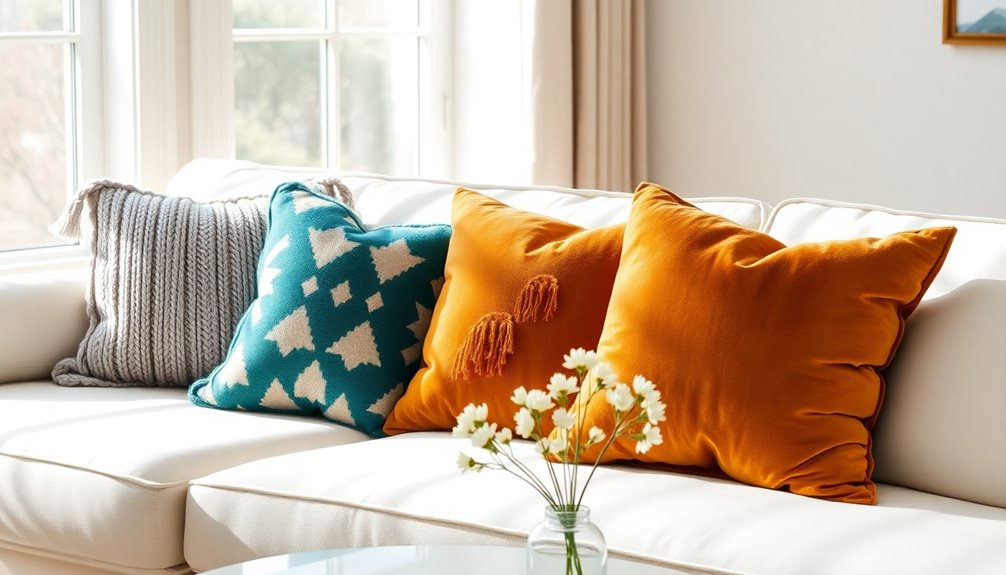To properly disassemble a sectional sofa, start by removing all cushions to gain access to the connectors. Ensure your workspace is free from any obstacles to prevent accidents. Locate the main disconnect point, typically found at the square corner, and check for any hidden clasps or clips. Lift the connectors straight up or slide them out while listening for a click to confirm detachment. If there are bolt connectors, remember to unscrew any bolts before separating the pieces. By following these steps, you can safely disconnect your sectional sofa. If you’re interested in learning how to reassemble your sofa or properly maintain it, there is plenty more information available on the topic.
Key Takeaways
- Remove all cushions to access the connectors and separation handles easily.
- Locate the primary disconnect point, often at the square corner of the sectional.
- Check for hidden clasps or connectors before attempting to pull apart the sections.
- Lift connectors straight up or slide them out, listening for a click to confirm detachment.
- Ensure your workspace is clear to prevent accidents during the disassembly process.
Understanding Sectional Sofa Connectors

When dealing with sectional sofas, understanding the connectors is vital for a smooth disassembly process. These connectors play a significant role in how securely your sofa pieces fit together and how easily you can disconnect them when needed.
Knowing the importance of managing expenses can also apply to your furniture investments, guaranteeing you make informed decisions about your purchases and maintenance, similar to adhering to a budget plan.
You'll typically encounter three main types of connectors: alligator clips, interlocking connectors, and bolt connectors. Alligator clips use a latch mechanism to connect the male and female parts by aligning and pressing them together. They're usually mounted on the underside of the sectional.
Interlocking connectors, on the other hand, require careful alignment, with one connector facing up and the other down, spaced about 24 inches apart for stability.
If you have a power sectional, you might find bolt connectors, which feature an angled male bolt that slides into a female end, making disconnection simpler.
When you're disconnecting, remember to lift the connectors straight up or slide them out, depending on the type. Using the correct technique will prevent damage and guarantee a smooth separation process.
Understanding these connectors will make your disassembly task much easier and more efficient.
Steps to Disconnect a Sectional

To disconnect a sectional sofa, start by removing all cushions, which will give you clear access to the separation handles and connectors.
Additionally, make certain your workspace is clear to avoid any accidents while handling the furniture.
Once you've done that, locate the primary disconnect point, usually positioned at the square corner of the sectional.
Check for hidden clasps or connectors before attempting to separate the sections.
If your sectional has alligator clip connectors, lift the male end straight up to detach it.
For interlocking connectors, slide the male end out of the female counterpart to disconnect.
As you work, gently lift the piece near the connection.
Listen for a click; that's a good sign the piece has detached successfully.
If you find that adjacent pieces are lifting instead, try from the opposite side.
Reconnecting Your Sectional Sofa

Reconnecting your sectional sofa involves a few straightforward steps to guarantee a secure fit. Proper alignment is vital to ascertain that the sections fit together seamlessly, similar to how best vacuums for dust removal effectively eliminate dust and allergens from your home.
Follow these steps to make sure your sections are properly reconnected:
- Align the Pieces: Start by positioning the sections so they're aligned correctly, with self-ratcheting clips ready to connect to the triangular posts.
- Adjust the Clips: If necessary, spin the clips to achieve the right alignment. This adjustment is critical for a snug fit.
- Connect the Sections: As you push the sections together, listen for that satisfying clicking sound. This indicates that the connection is being made securely.
- Confirm Stability: Keep pushing until the clicking stops, which confirms that the sections are fully connected and stable.
Once you've successfully reconnected the sofa, don't forget to replace the attached cushions. This step not only enhances the sofa's appearance but also restores its comfort.
Maintenance Tips for Sectionals

Maintaining your sectional sofa is key to guaranteeing it stays in great shape after you've reconnected the pieces. Since sectionals come in multiple pieces, you should regularly inspect the connectors for any signs of wear and tear. This helps guarantee safe and secure connections over time.
Additionally, creating a mood board can inspire decorative choices that enhance your sectional's aesthetic and functionality. To keep the sofa looking its best, clean fabric surfaces with appropriate cleaners to prevent long-term stains or damage. It's also a good idea to periodically rotate cushions. This promotes even wear and prolongs the lifespan of the upholstery.
Don't forget to check for loose parts or bolts. Tighten them as necessary to prevent instability and guarantee safety during use.
Avoid placing heavy objects on the sofa, as this can compromise its structure and lead to sagging or breakage over time.
Additional Resources for Sofa Care

When it comes to caring for your sectional sofa, having the right resources at your fingertips can make all the difference. To keep your sofa looking great and functioning well, consider these essential tips:
1. Inspect Connectors: Regularly check the connectors for wear and tear. Make sure they're secure to avoid damage during rearrangement.
Additionally, understanding how to properly maintain your furniture can enhance its longevity.
2. Clean Fabric Surfaces: Use appropriate cleaning methods and products to maintain the appearance of your sofa. This helps prevent stains and prolongs its life.
3. Rotate Cushions: Periodically rotate the cushions to prevent uneven wear. This simple action guarantees comfort and keeps your sectional looking fresh.
4. Tighten Loose Parts: Check for any loose components and tighten them as necessary. This is vital for maintaining the overall structure and safety of your sectional.
Additionally, avoid placing heavy objects on your sofa. Doing so can stress connectors and frames, leading to long-term structural issues.
Frequently Asked Questions
Can You Detach Sectional Sofa?
Yes, you can detach a sectional sofa. First, look for connection points like hooks or clips. Remove cushions, check for hidden clasps, and gently lift adjacent pieces to see if they detach easily.
Can I Separate a Sectional Sofa?
Yes, you can separate a sectional sofa. You'll want to clear the cushions, locate the connection points, and gently lift the sections. If it's heavy, don't hesitate to ask someone for help.
How Are Sectional Sofas Attached?
Sectional sofas are attached using methods like alligator clips, interlocking connectors, or bolt connectors. Each type requires specific alignment or tools, so you should inspect your sofa to determine the exact connection before proceeding.
How to Take Apart a Sofa for Moving?
Taking apart a sofa for moving is like solving a puzzle. Start by removing cushions, locate connection points, and gently lift sections apart. Get help for heavier pieces to guarantee safety and prevent damage. Next, detach the legs or base if possible, as this can provide extra clearance. Rotating or angling sections can make it easier to fit a sofa through a door, especially in tight spaces. Remember to protect walls and door frames with padding to avoid scratches or dents while maneuvering.
Conclusion
Disconnecting your sectional sofa can be a straightforward process with the right approach. Did you know that nearly 40% of homeowners prefer sectionals for their versatility and comfort? By following the steps outlined, you can easily rearrange or move your furniture without hassle. Remember to maintain your sectional for longevity, and don't hesitate to consult additional resources for care tips. Enjoy your space, and make the most of your sectional's flexibility!









